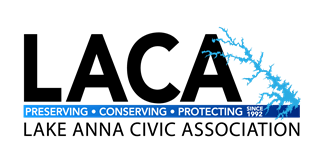By David Reichert – June 2025
A prior article in the LACA Newsletter1 described how shoreline plantings can absorb nutrients that are being washed into the lake. Floating islands effectively create additional area for what are normally shoreline plants in order to consume more nutrients. Another LACA Newsletter explained the correlation between high nutrient levels in the lake and HAB2. LACA with support from Dominion Energy and DuPont have installed trial floating islands on the lake. The commercial floating islands cost about $1000 and the 1st generation homemade islands cost under $100. The initial trials with these floating islands were a big success for the commercial islands, but the homemade islands didn’t hold up to boat wakes. LACA bought some more commercial floating islands, but what if we could increase the number of islands without the high cost?
Last summer, as the kids were running across our floating foam mat, a long tear opened as one of the boys stepped through the mat. The mat was no longer suitable as a play place, but what if it could be made to mimic the commercial floating islands? Some flexible glue, a box cutter, a hole saw, drill bits, some labor, and I had a floating island. The results can be seen in the photo below.
 The commercial islands use a much higher density of planting holes, so we’ll incorporate that in our 3rd generation homemade floating island. What we need from you is your old foam mat. We’ll cut them so that we can stack them 4 high. Generation 2 used glue, but generation 3 will use stainless bolts, nuts and washers to hold the islands together. We’ll cut 3” diameter holes through 3 layers to hold the plants and the coconut coir that holds the plant in place. The last steps are to drill 5 each ½” holes through the bottom layer, add the plants and anchor the island offshore. We use stainless eye bolts as the anchor points for the island.
The commercial islands use a much higher density of planting holes, so we’ll incorporate that in our 3rd generation homemade floating island. What we need from you is your old foam mat. We’ll cut them so that we can stack them 4 high. Generation 2 used glue, but generation 3 will use stainless bolts, nuts and washers to hold the islands together. We’ll cut 3” diameter holes through 3 layers to hold the plants and the coconut coir that holds the plant in place. The last steps are to drill 5 each ½” holes through the bottom layer, add the plants and anchor the island offshore. We use stainless eye bolts as the anchor points for the island.
Now that you know how to make a floating island, you can either do it yourself or donate your mat to LACA and we’ll turn it into a floating island. In either case, LACA will provide plants for the island. Reach out to me by email (David.Reichert@lakeannavirginia.org) or phone (804-291-8495) if you have a mat to donate or need plants for your own island.
1 “Protecting Lake Anna’s Shoreline,” Lake Anna Civic Association - Protecting Lake Anna’s Shoreline
2“Update on the Phosphorus Remediation Program at Lake Anna,”Lake Anna Civic Association - Update on the Phosphorus Remediation Program at Lake Anna
david.reichert@lakeannavirginia.org
